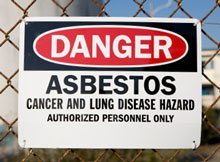Hundreds of Mesothelioma Deaths Predicted for Taiwan
 Taiwanese cancer researchers say a total asbestos ban is “urgently needed” to help stem the tide of pleural mesothelioma cases predicted in the next 30 years.
Taiwanese cancer researchers say a total asbestos ban is “urgently needed” to help stem the tide of pleural mesothelioma cases predicted in the next 30 years.
While the incidence of malignant mesothelioma has finally begun to level off in some countries, its incidence worldwide continues to grow.
Taiwan is just one example of a country where mesothelioma rates, as well as the rates of other asbestos-related diseases (ARDs), are expected to keep climbing for at least another couple of years.
Even after 2020, the authors of a new mesothelioma study say the disease will continue to be a problem for decades, highlighting the need for Taiwan to implement a total asbestos ban and devote more resources to mesothelioma screening, diagnosis, and treatment.
Predicting Pleural Mesothelioma Deaths
Malignant mesothelioma is one of the most deadly consequences of exposure to the mineral asbestos. Around the world, tens of thousands of people who have lived or worked around asbestos have died of mesothelioma, lung cancer, asbestosis, or another asbestos-related cancer.
Because malignant mesothelioma rates correlate with levels of asbestos exposure, environmental medicine researchers with Taiwan’s National Institute of Environmental Health Sciences collected data on asbestos consumption in the country from 1939 to 2015 to predict rates for the future.
While Taiwanese asbestos consumption reached its peak in the 1980s, the long latency period associated with pleural mesothelioma (25 to 45 years) means that people exposed decades ago are still getting sick and the trend is likely to continue.
“Given a latency period of 31 years, malignant pleural mesothelioma incidences were expected to peak around 2012-2016 for males and 2016-2020 for females,” writes lead study author and occupational medicine expert Ro-Ting Lin. “In 2017-2046, the predicted total number of new MPM might reach 659 cases.”
Between 1939 and 2015, the researchers observed that the annual number of mesothelioma cases increased nine-fold in men. For women, the number of new mesothelioma cases increased six-fold.
Addressing the Problem of Pleural Mesothelioma
Scientists have not yet found a cure for pleural mesothelioma and the prognosis is usually poor. Earlier detection through screening of asbestos workers may help catch some cases earlier, increasing the odds for better outcomes.
“Approximately 659 new malignant pleural mesothelioma cases in the next 30 years warrant an urgent need to implement a total asbestos ban and put more resources on a comprehensive surveillance, diagnosis, and follow-up health care system for ARDs,” writes Dr. Lin.
Taiwan has a long history of asbestos mining and manufacturing since Japanese colonial times. Although its EPA classified asbestos as a “group 1 carcinogenic substance” and a “category 2 toxic chemical substance” decades ago, it was not until this year that they stopped the last allowable use of asbestos – asbestos brake pads.
Taiwanese companies which were licensed to produce asbestos brake pads before the ban can continue to do so until their license expires.
Sources:
Lin, R-T, et al, “Upcoming epidemic of asbestos-related malignant pleural mesothelioma in Taiwan: A prediction of incidence in the next 30 years”, July 30, 2018, Journal of the Formosan Medical Association, Epub ahead of print
Wu, H, et al, “Transnational Dynamics Amid Poor Regulations: Taiwan’s Asbestos Ban Actions and Experiences”, October 2017, International Journal of Environmental Research and Public Health





